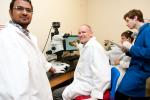Thomas Werner's Profile

- Member for:
11 years 4 months - Institution:
Michigan Technological University - Website:
http://www.mtu.edu/biological/department/faculty/werner/
Biography
Dr. Werner became interested in the question “What is life?” as a four-year old child in his parent’s garden in former East Germany. With the age of 10, he began to develop a life-long interest in the biology of butterflies and moths. He has been breeding and collecting them ever since. For his Master’s thesis, he decided to shift his focus to molecular biology because this was a newly emerging field of biology that promised new jobs. Thus, Dr. Thomas Werner studied the human heart disease-causing virus Coxsackie B3 at the molecular level at Friedrich-Schiller-University Jena in Germany. After the fall of the Berlin Wall, Dr. Werner made one of his childhood dreams become true and moved to Sweden. He spent seven years in Umeå, working on his Ph.D. thesis about the innate immune response in the fruit fly Drosophila melanogaster. During this time at Umeå University in Dr. Dan Hultmark’s lab, he discovered and described a new family of immune genes that we humans share with flies and many other animals. In 2005, Dr. Werner shifted his research focus towards evolution of development (evo-devo) and worked as a postdoctoral fellow at the University of Wisconsin-Madison in Dr. Sean B. Carroll’s lab, where he established the fruit fly Drosophila guttifera as a new transgenic model organism to investigate how complex animal color patterns evolve.
Thomas's research projects
Cancer is caused by genes that were originally "good" genes that have turned "bad". Every organism needs these genes to develop from an egg into an adult, but when they mutate, they cause tumor development and growth.

 Gifts to projects listed on SUPERIORIDEAS.ORG are received and processed by Michigan Tech Fund. Michigan Tech Fund is a tax-exempt organization under Section 501(c)(3) of the Internal Revenue Code acting on behalf of Michigan Technological University. It is the policy of Michigan Tech Fund that a portion of the gifts and/or income therefrom may be used to defray the costs of raising and administering the funds.
Gifts to projects listed on SUPERIORIDEAS.ORG are received and processed by Michigan Tech Fund. Michigan Tech Fund is a tax-exempt organization under Section 501(c)(3) of the Internal Revenue Code acting on behalf of Michigan Technological University. It is the policy of Michigan Tech Fund that a portion of the gifts and/or income therefrom may be used to defray the costs of raising and administering the funds.